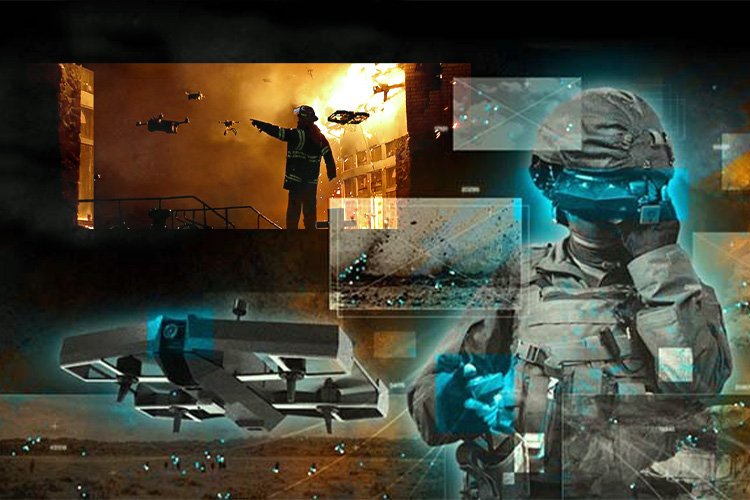Under cover of darkness, a highly trained special operations team creeps towards a dreary three-story cinder block home. Concealed by a starless sky, only the rhythmic crunching of the soldier’s boots against the baked earth and the occasional barking of a faraway dog disturb the cool night air.
The soldier’s mission: Capture or kill a senior leader of an international terrorist cell discovered hiding in a remote corner of the Idlib provenance of northern Syria.
The men conducting this mission are some of the best-trained and well-equipped warfighters in the world. Nevertheless, to successfully complete the job, most of these soldiers will have to blindly enter this inhospitable dwelling.
Intelligence analysts have done their best to anticipate what the operators will encounter. However, the actual dangers the men will face remain unknown until they cross the threshold.
Above, a sophisticated surveillance drone quietly monitors the team’s every move. Thousands of miles away, a group of steely-eyed military leaders is transfixed by a live feed being beamed from nearly a world away. The palpable tension seemingly defies time and space.
In this instance, the special forces soldiers, mission, and entire scenario are all works of fiction.
This imagined scene does, however, accurately reflect an untold number of similar high-risk missions regularly carried out by special operations or counterterrorism forces all across the world.
And these are also precisely the types of dangerous and unpredictable scenarios that the CEO and co-founder of the Israeli technology company XTEND, Aviv Shapira, wants to eliminate.
Sitting down for an exclusive interview with The Debrief, Shapira discussed how he and his colleagues at XTEND are working at the intersection of artificial intelligence and human-machine teaming to revolutionize the robotics and drone industry.
“So basically, XTEND is building an operating system that allows operators to conduct their missions remotely by mixing different types of technologies that traditionally have never met, like V.R. [virtual reality] and A.R. [augmented reality],” explained Shapira.
XTEND’s ultimate goal? To disrupt the status quo and fundamentally change the way robotic systems perform a variety of high-risk roles to improve efficiency and mission capabilities and, most importantly, preserve human life.
Developing a disruptive technology that forever shifts an industrial landscape is, of course, a challenging task.
Yet, examining what XTEND has brought to the table in just four short years since its founding, it’s hard to ignore the possibility that Shapira and his team are at the forefront of a new era in technological breakthroughs.
“There’s a saying that you can bring someone water from the well by carrying it, or you can just build the pipe to the world, and then they have water all the time,” remarked Shapira. “This is how I see things. So, let’s build a technology that would disrupt how things are being done today.”
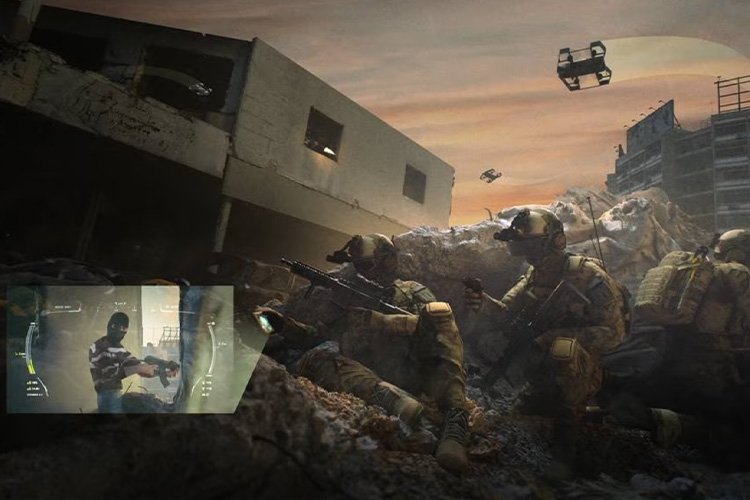

In a basic example of XTEND’s potential, Shapira demonstrates how a small box-framed quadcopter using the company’s operating system can fly through the open window of a two-story building. Once inside, the drone quickly begins a room-to-room search, transmitting live-feed video to a remote operator.
As the UAV comes across objects of interest, such as a person hiding in one of the rooms, the system highlights the items, offering valuable insights to its human partners who are safely waiting outside.
What makes the demonstration so remarkable is that its human operator only told the drone to enter and conduct a search. The drone performed all of the complex flight dynamics and further investigation autonomously.
By combining the latest A.I. and augmented reality advances, XTEND’s operating system has completely removed the need for conventional UAV flight controls.
“Our drones and our robots don’t have sticks. You don’t tell them to go left, go front, go hear, jump, or whatever. You tell it what you want it to do, you give them tasks, go through the window, you know, break this window, chase this car, do this or do that,” said Shapira.
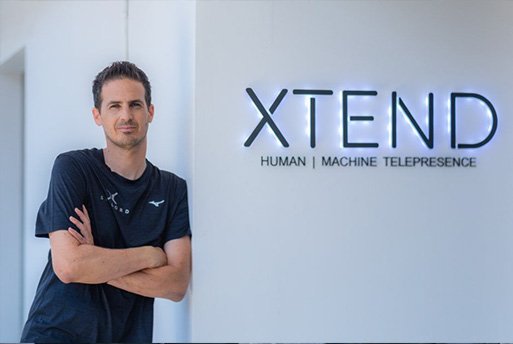

“We call this task and fly, or task and drive, depending on if you’re flying or driving, and it basically removes all of the cognitive load involved with controlling remote robots.”
Instead of having manual controls, dictating roll, pitch, yaw, and throttle, a user wearing a V.R. headset or working from a remote base station can simply point in a direction or issue a set of commands for the drone to respond.
Shapira illustrates how a user with zero UAV flight experience can instantly operate a drone in virtually any scenario, regardless of the complexity of the environment, thanks to XTEND’s patented “Mark & Fly” software.
“This green marker, which you see here, is controlled using gestures,” Shapira points to an area in the center of the drone’s heads-up display. “You move your head and basically point in space where you want to go.”
In another demonstration, a UAV enters the cluttered equipment room of a nearby parking garage. The drone navigates the crowded space smoothly, dodging piping and equipment with ease.
“We just did a demo for eight people from Germany,” remarks Shapira. “And every one of them flew after one minute. Between windows and doors. Yeah, it’s easy.”
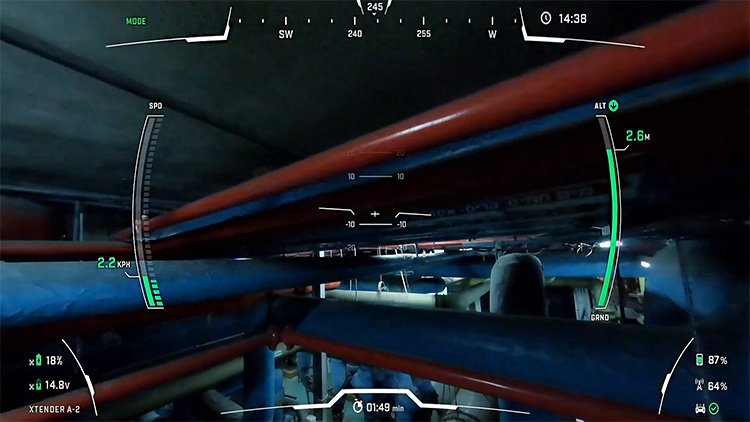

While the system’s automated flight controls are striking, the cornerstone of XTEND’s mission is ensuring the most powerful operating system in the human-machine relationship- the human brain – stays in the equation.
“Today, drone companies and robotics companies are either fully manual, so you actually control a drone. Or you have the other end of the scope, trying to go all the way autonomous,” explains Shapira. “You know, let the drone enter the building and somehow find the big bad guys and eliminate them.”
“It doesn’t really work,” Shapira shakes his head. “You need human discretion. You need human situational awareness. You need human thinking first. So this is basically our mission [at XTEND].”
Instead of replacing humans, Shapira wants to use A.I.’s ability to process and analyze vast amounts of data in real-time to enhance human potential during high-risk situations.
Instead of blindly entering a hive of angry terrorists, had the special forces operators in the opening fictional scenario been equipped with a drone using XTEND software, the team could have sent a small UAV in first. Ultimately providing operators with invaluable intelligence and the ability to adapt a plan of action based on accurate real-time information.
Shapira, however, makes it clear that searching buildings for lurking bad guys is hardly the limit of XTEND’s potential.
Using the earlier two-story building example, Shapira demonstrates how XTEND can create a 3D reconstruction of an area it’s scanned, allowing a user to go back in time and fly around using virtual reality.
To be clear, this is more than just re-watching the drone’s initial video footage.
Using data gathered during its initial search, XTEND’s software recreates a fully immersive 3D environment, allowing an operator to chart a totally new flight path or in-depth exploration.
The ability to explore an immersive three-dimensional recreation of a specific time and space offers the first glimpse of XTEND’s potential beyond what Sparia calls the “risk-takers marketplace” (e.g., military, law enforcement, firefighters).
Imagine, for example, the ability for future scholars or students to independently explore exact recreations of historical events recorded by XTEND’s software.
Continuing the tour, Shapira demonstrates how the XTEND’s operating system can also give drones the ability to perform physical tasks and interact with their environment.
“Another use case of the technology is what we call multimission. Basically, replacing soldiers in the field by allowing interactivity or UAS that can do things like place payloads, pick up things, or drop things,” explained Shapira. “This is mostly used to counter IEDs, place bombs or cyber payloads, counter other drones, or perform supply drops of ammunition, foods, medicine… basically whatever.”
In a series of videos, drones supported by XTEND are shown picking up and dropping various payloads, including delivering a simulated package with pinpoint accuracy.
Addressing a topic that has become a significant concern for virtually every corner of the defense world, XTEND can also counter threats posed by small unmanned aerial systems.
For counter-UAS missions (cUAS), Shapira shows a quadcopter being cannibalized by a unique high-speed drone capable of flying at over 90 mph. The cUAS drone can either beat its aerial adversary to death with poles mounted to its frame or ensnare its prey using a deployable net, offering two variations of the same result.
“All of these [examples] use the same software,” explains Shapira. “And this same software basically allows us to do almost anything remotely.”
To this point, it’s essential to understand that XTEND’s potential for human-machine teams to perform various complex tasks is not limited to any particular make and model of UAV.
At its core, XTEND is an operating system for robotic platforms in the same way Android or Apple’s iOS software provides the backbone for most smartphones.
“It’s much easier for me to show you drones flying and doing things than it is to talk about software,” says Shapira. “But essentially, XTEND is not building drones. XTEND is a pure software business creating an operating system.”
Shapira explains that XTEND’s software opens the door for outside developers to create applications tailored for specific missions or tasks just like any other operating system, such as Windows for personal computers.
“We understand we don’t know everything about this market,” acknowledged Shapira. “So we allow other developers to actually develop their own applications that can sit on the operating system. Pretty much like Google Play or the Apple App Store.”
For those looking for an off-the-shelf option, a Washington, DC-based subsidiary, XTEND Defense, offers a line of small UAVs capable of performing various complex tasks using XTEND’s operating system.
One model, the XTEND Griffon, is a handheld UAV specifically designed for counter-UAS missions. According to the company’s website, the Griffon can fly up to 80 mph to “kinetically intercept aerial threats.”
Another model, the XTEND Wolverine, is a multi-mission drone capable of performing delicate pick-up and drop tasks with “surgical precision.”
Yet, Shapira says, at its core, XTEND’s operating system is what’s spearheading a new era of human-machine teaming.
“And there are many, many applications we haven’t thought about [yet]. I mean, for example, if we look at subterranean challenges, going inside tunnels, and so we started to do it, but it all depends on a customer’s request and needs.”
Headquartered in Tel Aviv, XTEND was founded by Aviv and his brother Mattheo and software engineers Rubi Liani and Adir Tubi.
“We started out building an operating system for racing drones,” explains Shapira. “We wanted to build a league where anyone could fly. Fly [a drone] 150 kilometers per hour, very easily.” XTEND’s Rubi Liani also co-founded FRIL, Israel’s official drone racing league.
In 2018, while working on a system that would easily allow anyone to compete in drone races, Hamas militants began launching attacks against Israel using waves of incendiary balloons.
Dubbed “terror kites” by Israeli media, a study published in the journal Security and Defence Quarterly found that the weaponized balloons posed “a serious threat to advanced Israeli defense systems, solely because of their primitive and unpredictable character.”
Seeing their homeland being attacked, Shapira says he and his colleagues turned their attention from racing drones to seeing what they could do to stop this emerging airborne threat.
“One of the first things we did, just on the weekends, was to help the Israeli Defense Forces deal with kites and balloons flying from Gaza with incinerating bombs,” said Shapira. “We just… we just wanted to help.”
“It became a very big thing. We were the only system able to intercept these balloons in the sky. And we decided that, for us, defense and public safety are much more impactful than gaming.”
Shapira speaks with quiet intensity when discussing XTEND’s origin story. A glint of moral reflection suggests that the CEO’s ambitious goal of disrupting the drone industry is likely motivated far more by altruism than one might assume.
“You don’t get a lot of chances in life to actually help people,” said Shapira deferentially.
“I’ll tell you my thesis here. So you can spend your time and go help someone like someone who is older, or kids in distress, and that’s your time being spent,” Shapira continued.
“But if you build the technology, that will allow Security and Defense personnel not to step into dangerous places and not to go into places they don’t need to go. You’re making an impact at scale. And that’s for me that’s the mission here.”
While “risk takers” make up XTEND’s primary market, Shapira makes it clear that this does not mean only military or police. Instead, he says the technology allows drones to perform numerous dangerous tasks that humans would otherwise carry out.
Some obvious non-military applications include the ability of drones to quickly perform damage assessments or medical triage in the wake of natural disasters. Human-guided autonomous drones could be equally beneficial in high-rise bridge inspection or surveying natural mines.
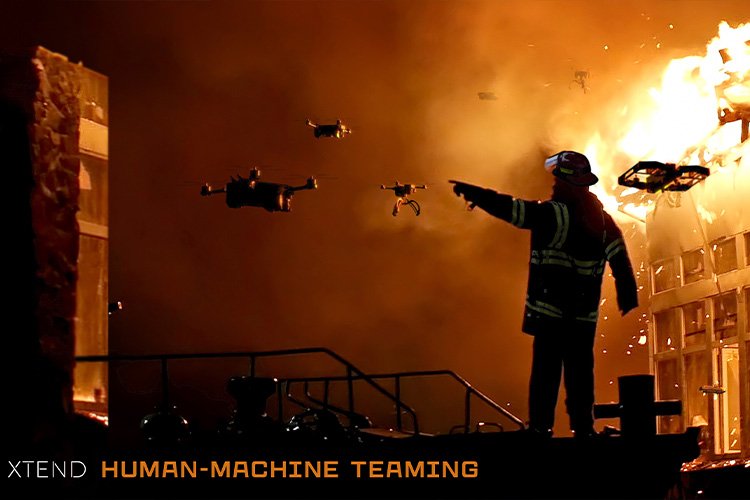

The law enforcement sector could stand to benefit the most from XTEND’s technology.
By striking a balance between A.I., autonomy, and human-machine teaming, the software could provide the average street cop with its own small UAV “loyal wingman.”
With this, a drone could capture video evidence with far greater fidelity than body-worn cameras, check out suspicious vehicles, search buildings, make initial contact with dangerous persons, or even pursue fleeing suspects. All while simultaneously keeping an officer out of harm’s way.
While speaking with The Debrief, Shapria points out that XTEND’s potential is not theoretical. The software is already being successfully used in high-risk situations.
“That’s the good thing about opening such a company in Israel. If we opened it in the U.S., it would be a theoretical technology. But in Israel, we’ve already had two wars in the last six years.”
“Companies like Skydio, Undraw, and Shield AI; all of these big, big, and great companies. They’re much better than us at some things, and we’re better than them at other things. But we have three years of operational experience,” explained Shapira.
“We know it’s working in battle. We went through so many bugs that came from wars, and this experience is something that’s irreplaceable. You cannot buy it somewhere.”
XTEND’s ability to keep a human operator firmly in the loop is significant as autonomous drone technology advances toward military applications.
Recently, The Debrief reported on a new classified initiative by the U.S. Defense Advanced Research Agency, DARPA, the “Autonomous Multi-Domain Adaptive Swarms-of-Swarms” program, or “AMASS.”
With AMASS, DARPA hopes to mature existing technologies to ultimately have the capability to unleash thousands of autonomous land, sea, and air drones capable of overwhelming and dominating an enemy’s area defenses.
When speaking with The Debrief, a DARPA spokesperson reiterated that a key component of AMASS was ensuring that critical, potentially lethal decisions were being made by humans and not machines.
“The central technical challenge of this program is to design human-in-the-loop planning and establish criteria to bound the autonomous operations. This includes the establishment of geofences for allowed operations, required confidence levels and permissions before taking action, and automated mission termination,” a DARPA spokesperson explained.
Rubi Liani, co-founder and CTO of XTEND, says keeping human beings in the consequential decision-making process is imperative.
“As a software company, we believe that it is critical that humans remain in control of any operation, irrespective of whether it is in a public safety, security, inspection, or combat scenario,” Liani told The Debrief. “That is why we have developed XOS, our patented operating system, which enables true human and machine collaboration, on the ground, in any scenario.”
“Scalable and infinitely flexible, XOS allows humans to connect and interact with drones, robots, vehicles, smart devices, and smart machines remotely, safely, and intuitively. Letting almost anyone to control multiple remote machines simultaneously – using advanced AR and VR technology on top of an AI layer,” added Liani.
“XOS is hardware agnostic, so it can be used to control all sorts of drones, complementing existing technology, or creating entirely new systems from scratch. Our open architecture means that we can host applications that have been developed by other companies too. That is why we believe that XOS will become the operating system of choice for anyone who is looking to maximize the potential of their drone and robotic systems, while decreasing the risks posed to their teams’ lives.”
XTEND has already received multiple contract awards from the U.S. Department of Defense’s Irregular Warfare Technical Support Directorate for drone products.
In late January, it was announced that the Israeli Ministry of Defense had awarded XTEND with a $20 million contract for developing and supplying its first-of-a-kind multi-drone operating system to the IDF.
Shapira acknowledges that it’s not just the “risk takers” lives that XTEND can help protect but also the lives of innocent persons who might otherwise find themselves caught in the crossfire.
Much debate goes on inside national security agencies over the best way to go after bad guys once they’ve been located.
Today, it typically comes down to one of two options. Conducting a precision missile strike, thus reducing any threat to your soldiers but increasing the risk of innocent bystanders falling victim to “collateral damage.”
Conversely, you can put boots on the ground, tasking a special operations team, like the U.S. Navy’s SEAL Team Six or Army Delta Force, to go in and get the bad guy. Option two dramatically reduces the risk to innocent persons, but at the expense of putting your troops in danger.
Shapira and his colleagues want to give mission planners a third option. One that doesn’t place anyone in harm but also gives those involved the unprecedented ability to make decisions based on real-time information.
If XTEND is successful, soldiers, law enforcement officers, firefighters, or even high-rise building surveyors, would never have to blindly place themselves in harm’s way.
And while XTEND’s overarching goal is admittedly bold, the ability to achieve what they are already doing at scale represents a true game-changing, disruptive technology.
When asked if he has considered that XTEND may have already saved lives, Shapira briefly pauses and gazes off in meaningful thought.
“We work with a lot of customers. And one of these customers is very special to me,” Shapira confides.
“Every time they use our technology, and every time, you know, like a life was saved, potentially, they send me a message that just says ‘thank you.'”
“Sometimes, it’s three o’clock at night, but you get this ‘thank you,’ and you know… you know you did good.”
Tim McMillan is a retired law enforcement executive, investigative reporter and co-founder of The Debrief. His writing typically focuses on defense, national security, the Intelligence Community and topics related to psychology. You can follow Tim on Twitter: @LtTimMcMillan. Tim can be reached by email: tim@thedebrief.org or through encrypted email: LtTimMcMillan@protonmail.com
